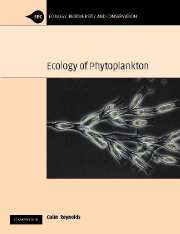Book contents
- Frontmatter
- Contents
- Preface
- Acknowledgements
- Chapter 1 Phytoplankton
- Chapter 2 Entrainment and distribution in the pelagic
- Chapter 3 Photosynthesis and carbon acquisition in phytoplankton
- Chapter 4 Nutrient uptake and assimilation in phytoplankton
- Chapter 5 Growth and replication of phytoplankton
- Chapter 6 Mortality and loss processes in phytoplankton
- Chapter 7 Community assembly in the plankton: pattern, process and dynamics
- Chapter 8 Phytoplankton ecology and aquatic ecosystems: mechanisms and management
- Glossary
- Units, symbols and abbreviations
- References
- Index to lakes, rivers and seas
- Index to genera and species of phytoplankton
- Index to genera and species of other organisms
- General index
Chapter 8 - Phytoplankton ecology and aquatic ecosystems: mechanisms and management
Published online by Cambridge University Press: 07 August 2009
- Frontmatter
- Contents
- Preface
- Acknowledgements
- Chapter 1 Phytoplankton
- Chapter 2 Entrainment and distribution in the pelagic
- Chapter 3 Photosynthesis and carbon acquisition in phytoplankton
- Chapter 4 Nutrient uptake and assimilation in phytoplankton
- Chapter 5 Growth and replication of phytoplankton
- Chapter 6 Mortality and loss processes in phytoplankton
- Chapter 7 Community assembly in the plankton: pattern, process and dynamics
- Chapter 8 Phytoplankton ecology and aquatic ecosystems: mechanisms and management
- Glossary
- Units, symbols and abbreviations
- References
- Index to lakes, rivers and seas
- Index to genera and species of phytoplankton
- Index to genera and species of other organisms
- General index
Summary
Introduction
The purpose of this chapter is to assess the role of phytoplankton in the pelagic ecosystems and other aquatic habitats. The earliest suppositions to the effect that phytoplankton is the ‘grass’ of aquatic food chains and that the production of the ultimate beneficiaries (fish, birds and mammals) is linked to primary productivity are reviewed in the context of carbon dynamics and energy flow. The outcome has a bearing upon the long-standing problem of phytoplankton overabundance and related quality issues in enriched systems, its alleged role in detracting from ecosystem health and the approaches to its control.
The chapter begins with an overview of the energetics and flow of primary product through pelagic ecosystems, especially seeking a reappraisal of the relationship between biomass and production.
Material transfers and energy flow in pelagic systems
One of the essential components of ecological systems is the network of consumers that exploit the investment of primary producers in reduced organic carbon compounds. Some of these are re-invested in consumer biomass but much of the food intake is oxidised for the controlled release of the stored energy in support of activities (foraging, flight, reproduction) that contribute to the survival and genomic preservation of the consumer species in question. In thermodynamic terms, the food web serves to dissipate as heat that part of the solar energy flux that was photosynthetically incorporated into chemical bonds (see p.355).
- Type
- Chapter
- Information
- The Ecology of Phytoplankton , pp. 387 - 436Publisher: Cambridge University PressPrint publication year: 2006
- 1
- Cited by

